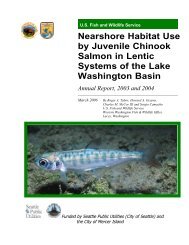2005 State of Mobility Report - City of Bellevue
2005 State of Mobility Report - City of Bellevue
2005 State of Mobility Report - City of Bellevue
Create successful ePaper yourself
Turn your PDF publications into a flip-book with our unique Google optimized e-Paper software.
CHAPTER 6<br />
Neighborhood Programs and Services<br />
6<br />
Preserving the quality <strong>of</strong> life in the city’s neighborhoods is a priority for the <strong>Bellevue</strong> <strong>City</strong> Council and<br />
Transportation Department. A well designed transportation system can improve neighborhood livability<br />
by reducing cut-through traffic, enforcing speed limits, and providing options for non-motorized travel.<br />
In addition to constructing large-scale capacity projects that keep commuter traffic on major arterials and<br />
regional facilities, the <strong>City</strong> funds neighborhood programs to ensure the integration <strong>of</strong> mobility and livability<br />
on its residential streets.<br />
When traffic problems on neighborhood<br />
streets become a daily occurrence, our sense <strong>of</strong><br />
community is threatened. To lessen the impact <strong>of</strong><br />
concerns, such as cut-through traffic, higher than<br />
posted vehicular speeds, overflow parking, and<br />
pedestrian safety (especially in school zones), the<br />
<strong>City</strong> promotes an array <strong>of</strong> neighborhood-focused<br />
programs, including:<br />
• Neighborhood Traffic Calming Program (NTCP)<br />
• Neighborhood Enhancement Program (NEP)<br />
• Residential Permit Parking Zone Program (RPZ)<br />
• Traffic Safety Technologies<br />
A hallmark <strong>of</strong> these programs is how closely <strong>City</strong><br />
staff work with citizens to address community<br />
concerns in a manner consistent with city policy<br />
and neighborhood characteristics.<br />
Preserve the safety <strong>of</strong> residential streets and<br />
the livability <strong>of</strong> residential neighborhoods by<br />
discouraging non-local traffic on streets classified<br />
as local. Emphasize the following measures:<br />
• Continue a strong neighborhood traffic<br />
control program to discourage cut-through<br />
traffic on non-local arterials, and<br />
• Design new residential streets to discourage<br />
cut-through traffic while providing for<br />
connectivity.<br />
Comprehensive Plan Policy TR-115<br />
Neighborhood Traffic Calming Program<br />
In 1985 the <strong>City</strong> established<br />
the Neighborhood Traffic<br />
Calming Program (NTCP)<br />
to address excessive vehicle<br />
speeds, non-local traffic,<br />
accidents, and spill-over<br />
parking that <strong>of</strong>ten result<br />
from traffic congestion on<br />
arterial streets. Through a<br />
two-year phased approach<br />
— which includes community involvement in<br />
problem identification, project development and<br />
outcome evaluation — the <strong>City</strong> determines how<br />
residents perceive the traffic problems on their<br />
neighborhood streets, assesses the traffic conditions<br />
(i.e., speed studies), and determines what solutions<br />
from the NTCP toolbox (see Chart 6-B for options)<br />
can best resolve the issues.<br />
6-A. Neighborhood Traffic Calming<br />
Program Requests, 2001-<strong>2005</strong><br />
Year Number <strong>of</strong> Number <strong>of</strong><br />
Requests Projects*<br />
2001 89 38<br />
2002 86 30<br />
2003 54 21<br />
2004 65 27<br />
<strong>2005</strong> 77 36<br />
*Most <strong>of</strong> the project files are closed after the implementation<br />
<strong>of</strong> Phase I measures. However, each year 4-5 issues are<br />
advanced to Phase II.<br />
<strong>2005</strong> <strong>State</strong> <strong>of</strong> <strong>Mobility</strong> <strong>Report</strong> Chapter 6<br />
45

















